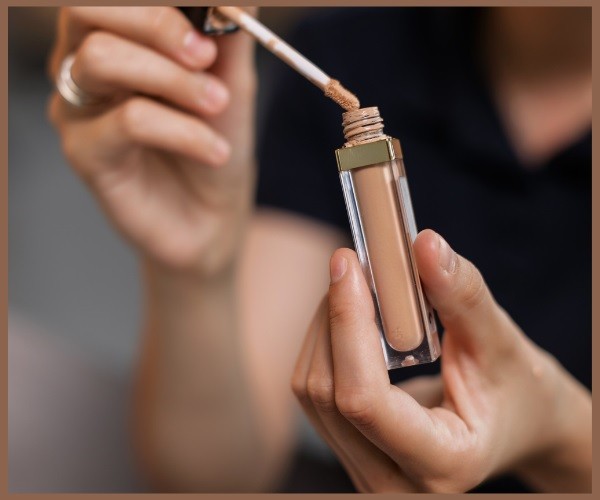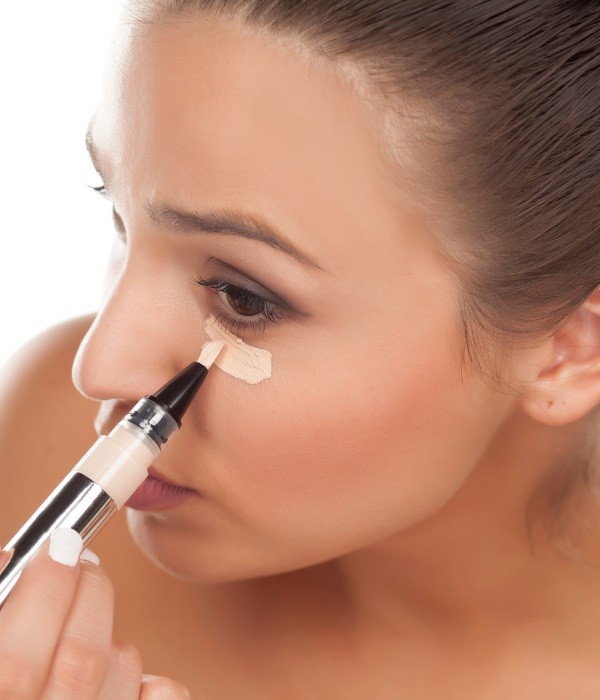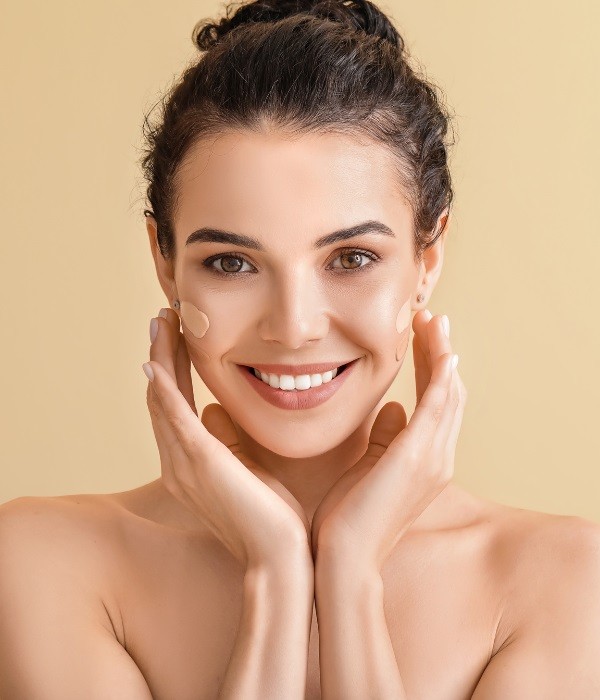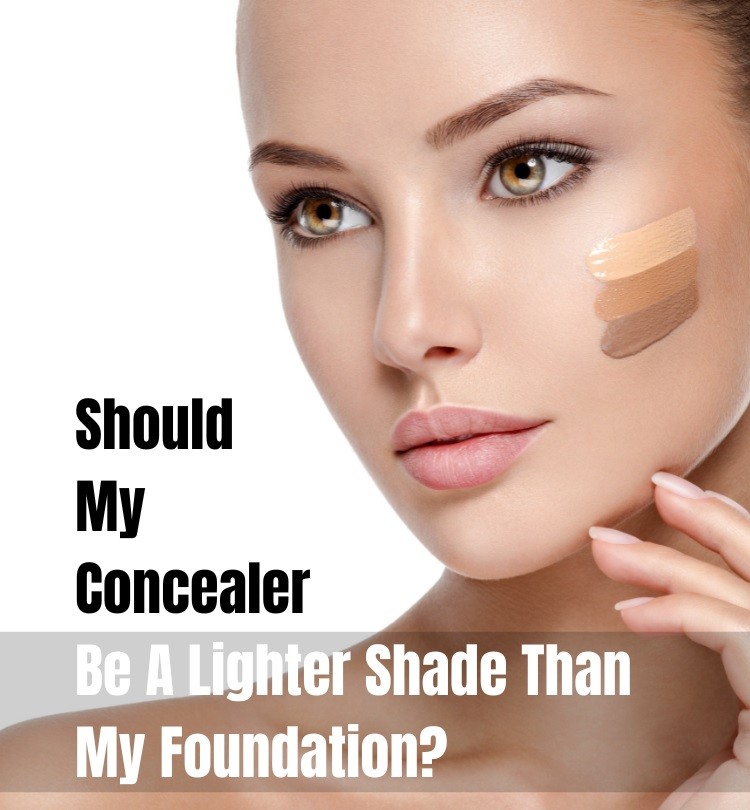This post contains affiliate links.
Updated on February 24, 2025
Yes, your concealer should be slightly lighter than your foundation. The purpose of concealer is to brighten and highlight the areas you want to accentuate, and using a lighter shade helps achieve this.
Choosing a concealer shade that is too dark can actually make your under-eye circles or blemishes more noticeable. Additionally, using a lighter shade can help create a more seamless transition between your foundation and concealer, giving you a more natural look.
It’s important to find the right shade for both your foundation and concealer to ensure your makeup looks flawless and enhances your natural beauty. We will write why a lighter concealer shade is recommended and how to choose the best shade for your skin tone and type.
Contents
The Relationship Between Concealer And Foundation Shades
Your makeup routine is not complete without foundation and concealer. Confusion may arise when it comes to matching the shades of these two beauty products. To achieve a flawless complexion, it’s essential to find the perfect match between your concealer and foundation shades.

Related: Does Baby Oil Help You Tan?
Introduction To Concealer And Foundation Matching
Matching your concealer and foundation shades can be a daunting task for many makeup enthusiasts. With a proper understanding of skin undertones and hues, you can master this skill with ease.
Here’s what you need to know:
- Foundation and concealer should be the same color as your skin tone.
- It’s unnecessary to choose a lighter shade of concealer than your foundation.
- You need to determine your skin undertones and hues to get your perfect match.
Understanding Skin Undertones And Hues
Understanding your skin undertones and hues is the first step in finding your perfect match between concealer and foundation shades. Undertones refer to the underlying hue of your skin, while hues refer to the surface color.
Here’s what you need to keep in mind:
- Undertones can be cool, warm, or neutral.
- You can determine your undertones by checking the veins in your wrist or trying on different jewelry tones.
- Your skin hue can change depending on factors such as tanning, illness, or aging.
Here are some guidelines that can help you choose the correct shade for your skin tone:
- For warm undertones, choose a foundation with yellow or golden hues.
- For cool undertones, choose a foundation with pink or red hues.
- For neutral undertones, choose a foundation that is neither too yellow nor too pink.
Tips For Matching Your Concealer And Foundation Shades
Now that you have an understanding of your undertones and hue, it’s time to choose the perfect match for your foundation and concealer.
Here are some tips to keep in mind:
- Always test the shades in natural daylight for the most accurate results.
- Test shades on your neck or chest instead of your face, as these areas have less pigmentation.
- If you have dark circles under your eyes, choose a concealer with a peach or orange undertone to neutralize them.
- Use a lighter shade of foundation or concealer to highlight specific areas of your face, such as cheekbones or brow bones.
Should My Concealer Be A Lighter Shade Than My Foundation?

When it comes to makeup, there is always some confusion around the right shade choice for both foundation and concealer. One of the most common misconceptions is that concealer should always be lighter than your foundation. This is not always the case.
Here are some misconceptions that need debunking:
- A lighter concealer is necessary to brighten under-eye circles.
- Matching the foundation and concealer’s’s exact shade is not important.
- A darker concealer helps to contour your face better.
All of these are myths, and we should choose our concealer shade carefully, keeping in mind our skin tone and foundation shade.
Related: Does Coconut Oil Help You Tan?
Why Matching Your Concealer To Your Foundation Is Important?
When it comes to choosing the right concealer shade, matching it to your foundation is crucial. Here are some reasons why:
- It helps create a seamless, natural-looking finish.
- The purpose of a concealer is to hide blemishes, redness, or dark spots. Matching concealer to the foundation will provide optimal coverage by making the blemishes disappear, without emphasizing them with a lighter or darker shade than the foundation.
- It provides an even skin tone, making you look more polished.
Matching your concealer shade to your foundation is key to achieving a flawless finish.
Benefits Of Using A Lighter Or Darker Concealer
While matching your concealer with the foundation is of utmost importance, it’s good to experiment with different shades to explore what suits you best. Here are some benefits of using a lighter or darker concealer:
Using A Lighter Concealer
- It can help brighten up the under-eye area.
- It can be used as a highlighter to draw attention to certain areas of the face, such as the brow bone or the bridge of the nose.
- It can make you look more awake and refreshed.
It’s important to choose a concealer only one or two shades lighter than your skin tone and foundation shade to avoid looking too washed out.
Using A Darker Concealer
- It can be used for contouring, giving more definition to the face shape by making certain areas look more prominent.
- It can be used to add warmth to the skin tone, especially when the foundation is too light for the skin tone.
Using a darker concealer incorrectly can make the face appear muddy and unnatural, which is why it’s important to choose the right shade and blend it well.
Choosing the perfect concealer shade is as important as picking the right foundation. By understanding these key points, you’ll be able to achieve a flawless, effortless-looking makeup application.
The Art Of Concealer Application
Concealer is a game-changer when it comes to covering up blemishes, dark circles, and other imperfections on your skin. But, to get the most out of this magical product, proper application is key. In this section, we will discuss the art of concealer application, which includes determining the right amount of coverage for your skin type and concerns, tools and techniques for flawless application, and achieving a seamless finish.
Determining The Right Coverage For Your Skin Type And Concerns
Before you start applying your concealer, it is essential to determine how much coverage you need. Using too much concealer can make your skin look cakey and fake. On the other hand, using too little concealer won’t give you the coverage you need.
Here are some tips to help you determine the right amount of coverage for your skin type and concerns:
- Start with a little amount and build it up gradually: It’s always better to start with less and add more if needed.
- Spot conceal: Only apply concealer where you need it, like blemishes, dark circles, or redness. This technique will prevent over-concealing and help you achieve a natural look.
- Choose the right formula: The level of coverage depends on the formula you choose. For light coverage, go for a liquid concealer. For more coverage, try a full-coverage concealer.
Tools And Techniques For Flawless Concealer Application
Once you figure out how much coverage you need, it’s time to move on to the tools and techniques you’ll need to get a flawless finish. Here are some tips to help you get started:
- Choose the right brush or sponge: The tool you use will depend on the formula you choose. For liquid concealer, a fluffy brush or sponge works best. For thicker formulas, try a dense brush.
- Tap and blend: The key to achieving a flawless finish is to tap and blend the concealer gently into your skin. Avoid rubbing or pulling the skin, as it can cause irritation and disturb the product.
- Use the triangle technique: Draw a triangle with the base under your eye and the point toward your cheek. This method will help you cover dark circles and give the illusion of lifted and brighter skin.
- Set your concealer with powder: To prevent your concealer from creasing or smudging, set it with a translucent powder.
Blend, Blend, Blend: Achieving A Seamless Finish
Blending is the most crucial step in concealer application. It ensures a seamless finish and prevents the concealer from looking obvious or cakey. Here are some tips to blend your concealer seamlessly:
- Blend with your fingers: The heat of your fingers will help melt the concealer into your skin, giving you a natural finish.
- Use a damp beauty sponge: Dampen your sponge, squeeze out the excess water, and use it to blend the concealer for an airbrushed finish.
- Layer and blend: If you still see any imperfections after the first application, layer the concealer and blend it again.
The art of concealer application involves determining the right amount of coverage, choosing the right tools and techniques, and blending it seamlessly. With these tips and tricks, you can achieve flawless-looking skin in no time. Remember, the key to perfect makeup is to practice, practice, practice!
Related: How To Use Tanning Oil?
Troubleshooting Concealer And Foundation Mismatch

How To Spot And Fix A Mismatched Foundation And Concealer Pairing?
- Identify the undertones of your skin. If you have cool-toned skin, look for a concealer and foundation with subtle pink or blue undertones. For warm-toned skin, opt for yellow- or peach-toned concealer and foundation.
- Make sure to allow time for your moisturizer to absorb into your skin before applying any makeup. Use more hydrating formulas for the eye area as dry skin can lead to creasing of the concealer.
- Test your concealer in natural lighting to ensure it matches your foundation – swatch shades on your jawline, blend thoroughly and check the color in natural light. Blend outwards to prevent any harsh lines.
- If you find that you’ve applied a concealer shade that’s too light for your skin tone, lightly dab some foundation over the top to neutralize it. If your concealer is too dark, use a light-colored setting powder to alter the tone.
Choosing Shades That Complement Rather Than Clash With Your Skin Tone
- When selecting a foundation shade, ensure that it matches your skin as closely as possible. Try to avoid using a shade that is more than one or two shades lighter or darker than your skin tone. Test shades on your jawline or the side of your face in natural lighting.
- It’s important to remember that certain areas of your face may be lighter or darker than others – in this case, you can use color-correcting products before applying foundation. For example, orange color-correcting shades can be effective for combating dark circles under the eyes.
- For a natural look, blend your foundation from the center of your face outwards. This will help to give a more even finish and prevent any harsh lines.
Alternative Solutions For Common Makeup Mishaps
- If you find that your foundation consistently oxidizes and turns orange after application, try switching to a different brand with different pigments.
- If your foundation appears to melt off of your face during the day, try using a primer before applying your foundation. This will help to keep your foundation in place for longer periods.
- If you happen to apply too much foundation or concealer, using a slightly damp makeup sponge is an effective way to remove some of the excesses without disrupting the rest of your makeup.
And there you have it, a simple guide to troubleshooting your concealer and foundation mismatch. Remember to take your time selecting the right shades and test them in natural lighting. With a little patience and practice, you’ll have flawless, natural-looking skin in no time!
Frequently Asked Questions
Is It Better To Match Concealer Shade To Foundation?
Yes, it’s better to match your concealer shade to your foundation shade for a seamless finish.
Can A Darker Concealer Be Used With Foundation?
You shouldn’t use a darker concealer shade with your foundation as it can create an unnatural look.
Why Do Some People Use A Lighter Concealer?
Using a lighter concealer can brighten the under-eye area and create a highlighting effect.
How Can I Test If My Concealer Matches My Foundation?
Apply a small amount of the concealer on your jawline and see if it blends in with your foundation.
What If I Can’T Find A Perfect Match Between Concealer And Foundation?
If you can’t find a perfect match between your concealer and foundation, choose a concealer shade that’s slightly lighter than your foundation shade.
Conclusion
The answer to whether your concealer should be a lighter shade than your foundation is not a cut-and-dry one. It largely depends on your desired outcome and the coverage you seek. If you’re looking to brighten the under-eye area and create a highlighting effect, then a lighter shade would do the trick.
On the other hand, if you want to conceal and cover imperfections, then a shade that matches your skin tone or is slightly darker would be a better fit. It’s all about understanding the purpose and use of your concealer.
The goal is to create a natural, seamless look and enhance your features. It’s also essential to consider factors such as skin type and texture when selecting your concealers and foundation shades. So, experiment and find what works best for you.

